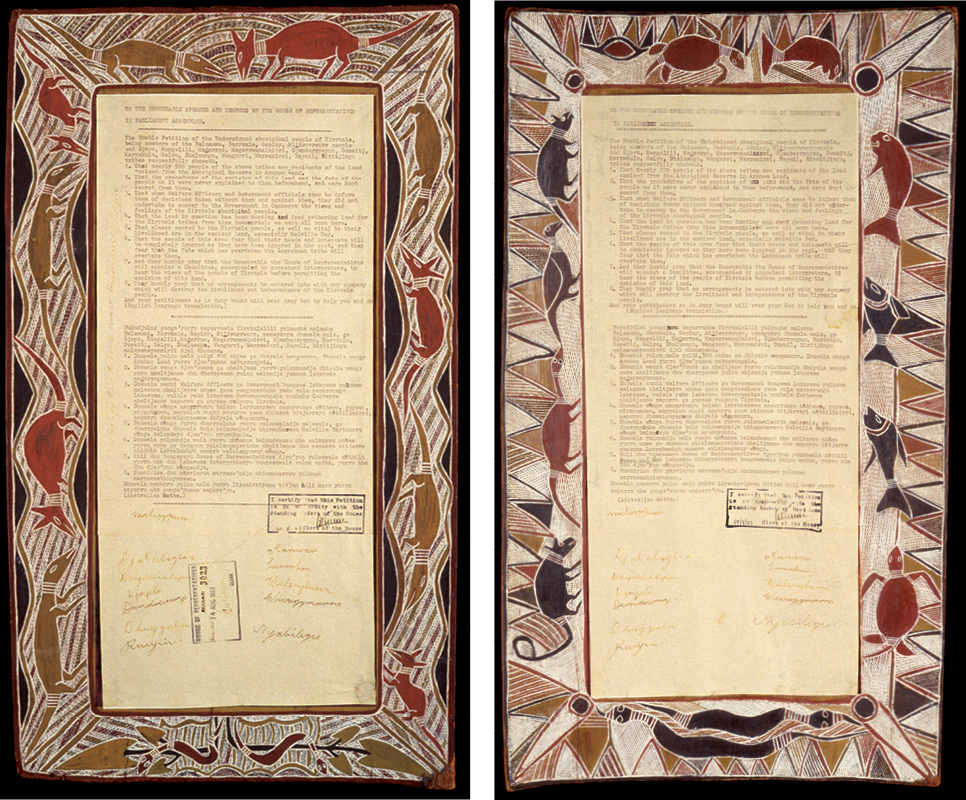Petitions
Petitions ask the Australian Parliament to act on an issue. This fact sheet explains the rules petitions must follow and how petitions are presented to the Parliament.
What will I learn?
- A petition is a request for the Parliament to act to solve a problem.
- Anyone can petition the Parliament.
- There are rules about how petitions should be written and presented to Parliament.
Curriculum alignment
Year 7 AC9HC7K02
Year 8 AC9HC8K01
What is a petition?
A petition is a request by a group of citizens for Parliament to act to solve a problem. It is one of the most direct ways citizens can draw attention to a problem and ask Parliament to help them. The Australian Parliament receives many petitions each year on many different subjects.
Petition presented in the Australian Senate to stop tariff cuts

The Department of the Senate
Description
This is a photo of the back of a white dinner jacket which has been written on in black marker. The jacket was presented to the Senate as a petition on 2 April 1992. The writing says:
‘PETITION TO STOP TARIFF CUTS To the Honourable the President and Members of the Senate in Parliament Assembled. We, the undersigned, including workers in the Textile, Clothing & Footwear Industries in the Federal Electorate of Wills, request that the Government: 1. Puts an immediate stop to TCF tariff cuts. 2. Calls a meeting of TCF employees & unions to identify specific products which need increased tariff protection and implement this. 3. Extends these measures to other industries.’
This is followed by a table with the following headings: Name, Address and Signature. The signatures have been blurred out for the photo.
How to prepare a petition
Petition presented in the Australian Senate to stop tariff cuts

The Department of the Senate
Description
This is a photo of the back of a white dinner jacket which has been written on in black marker. The jacket was presented to the Senate as a petition on 2 April 1992. The writing says:
‘PETITION TO STOP TARIFF CUTS To the Honourable the President and Members of the Senate in Parliament Assembled. We, the undersigned, including workers in the Textile, Clothing & Footwear Industries in the Federal Electorate of Wills, request that the Government: 1. Puts an immediate stop to TCF tariff cuts. 2. Calls a meeting of TCF employees & unions to identify specific products which need increased tariff protection and implement this. 3. Extends these measures to other industries.’
This is followed by a table with the following headings: Name, Address and Signature. The signatures have been blurred out for the photo.
A petition to the House of Representatives can be presented on paper or electronically. To be accepted it must:
- be about something the House is responsible for
- be clear what the petition is asking the House to do
- be addressed to the Speaker of the House of Representatives and members of parliament
- not promote anything illegal or contain offensive language
- be no longer than 250 words.
A petition to the Senate can also be presented on paper or electronically, and must:
- be addressed to the whole Senate
- contain a request for action written in respectful language
- be checked by the Clerk to make sure it meets the rules of the Senate standing orders
- be presented to the Senate on behalf of the petitioners by a senator.
Presentation to Parliament
The Senate and House of Representatives each have rules about how a petition can be presented to Parliament.
In the House of Representatives, petitions are presented on Mondays by the chair of the Petitions Committee. These are presented along with any responses by government ministers to petitions previously presented to the House. The chair will usually give a short speech at the same time. Petitions can also be presented by another member of parliament.
Petitions can be presented to the Senate on any sitting day by any senator.
After a petition has been presented to Parliament, the words of the petition and number of signatures are printed in Hansard. A petition may be sent to the minister responsible for the subject of the petition for their thoughts.
History

The Yirrkala petitions. Yirrkala artists, Dhuwa moiety, 14 August 1963 Yirrkala artists, Yirritja moiety, 28 August 1963
House of Representatives, Canberra
The Yirrkala petitions. Yirrkala artists, Dhuwa moiety, 14 August 1963 Yirrkala artists, Yirritja moiety, 28 August 1963

House of Representatives, Canberra
Description
These petitions were sent from Yirrkala, Northern Territory to the House of Representatives in 1963.The petitions are on 2 large rectangular pieces of bark. Each has a border decorated with traditional iconography of animals including turtles, snakes and fish. Inside each decorated border is a piece of paper with typed words, followed by handwritten signatures and stamps. The petitions have typed text in both Yolngu Matha and English.
Copyright information
Permission for publication should be sought from the House of Representatives Table Office at Table.Office.Reps@aph.gov.au
The right to petition the monarch and parliament to solve a problem dates back to the 13th century in Britain. At that time, proposed laws – bills – were little more than petitions to the monarch. Petitions in their current form date from the 17th century.
In the Australian Parliament, one of the most famous petitions was presented to the House of Representatives in 1963. The Yolgnu people of Yirrkala in the Northern Territory requested that Parliament recognise their traditional land on the Gove Peninsula in Arnhem Land, which was under threat from mining. This petition combined bark painting, words in English and Yolgnu, and Aboriginal designs. As a result of the Yirrkala Petition, the Parliament established a committee to investigate the issue.
Some unusual petitions have been presented to the Senate, including one that was written on a jacket. This petition related to the textile, clothing and footwear industries and was presented on 2 April 1992.